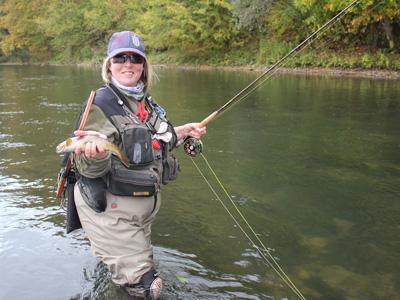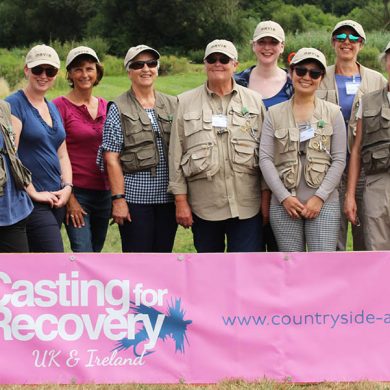Jeremy Lucas begins to develop his thoughts on specific river techniques in the latest in his ‘Frontier’ series.
A lot of readers of this series have mentioned specifics in river technique which are covered here.
I have already discussed aspects of dry fly (mostly with CDC plume tips) compared with nymph technique on various European rivers, most latterly about our group trips last autumn to Czech and Poland. As readers have noticed, we were so completely overwhelmed by our short stay in Sumava that it was with some regret that we left Czech and undertook the long, long drive to the San in south-east Poland, close to Ukraine.
 How could the fishing possibly match or even come close to what we all had experienced on Otava or Vltava? Wojtek had told us that the fishing on San had been good since the waters fell and warmed after last spring, but he would not elaborate, which left us intrigued.
How could the fishing possibly match or even come close to what we all had experienced on Otava or Vltava? Wojtek had told us that the fishing on San had been good since the waters fell and warmed after last spring, but he would not elaborate, which left us intrigued.
I have written about some of this wonderful trip both here and in the posts on my website, but I want to elaborate more, and in further pieces in this series, about some technical aspects of fishing large European rivers such as the San, as well as the more challenging among the wild streams of continental and alpine Europe. In my estimation, this is where the huge changes, or advances, have been made in contemporary fly fishing, much more so than in still water fishing or on the rivers of Britain.
This might seem a harsh generalisation, but the fact remains that one simply cannot improve one’s approach up to the high ‘European standard’, by fishing exclusively on British waters, and even less so by choosing the comparatively easy water on such rivers. I have said for a very long time, that this is a failing of many British competitors and I know all too well that the top continental anglers spend a great deal of time learning how to fish in difficult or more challenging situations.
One has only to look at almost any of the truly international competitions taking place nowadays (not including the parochial home internationals), such as, for example, the recent grayling international on the Welsh Dee, which saw European anglers, notably Daniel Svcrek of the Czech Republic, completely dominating the field. Competitive fly fishing does not define excellence in the sport, of course, but it is at least an indicator.
 It might seem contradictory, therefore, to infer that a high technical proficiency is required to fish the San, given that the fishing is almost alarmingly productive. Indeed, it would be entirely possible to achieve an apparently satisfactory, even impressive, catch on the San of nowadays, with very ordinary skills. This is not the point. Fishing on the Frontier has always been about exploring up to the limits, the boundary of what we can achieve and discover, and if possible pushing it a little further.
It might seem contradictory, therefore, to infer that a high technical proficiency is required to fish the San, given that the fishing is almost alarmingly productive. Indeed, it would be entirely possible to achieve an apparently satisfactory, even impressive, catch on the San of nowadays, with very ordinary skills. This is not the point. Fishing on the Frontier has always been about exploring up to the limits, the boundary of what we can achieve and discover, and if possible pushing it a little further.
When those who aspire to improving their sport ask me how best they might achieve this, in my view, I tell them that in the first instance they should stop choosing the obvious, ‘percentage’ water on British rivers. They should rather seek out those sections which hold fewer or more challenging fish, and learn how to extract the best from such locations; or perhaps to target the larger specimens, which will almost always be in the most ‘protected’ lies. Better still, they should travel to Europe: to the challenging chalk streams of the Artois, perhaps, or the fascinating, and hugely demanding, mountain streams of Pyrénées Atlantiques in France, or the Cantabrian sierra of northern Spain. Best of all, though, go to the San, and learn something of what is, by a considerable measure, the ultimate in what the single-handed fly rod sport possesses.
It is the scale of the San, quite apart from its extraordinary fishing potential, that is so disarming, more so than on the comparatively small rivers of Czech. Far broader than any of these, or any English trout and grayling river, it is, rather, like a multitude of streams, and the angler should deal with it as such. In a hundred metre length of the tailwater section, or downstream where is is even broader, one will find numerous water types, each requiring a different approach, and the extent of this, coping with it all, is somewhat unnerving. It takes time. I well remember this feeling during my early years exploring the San, which resulted in me pushing too quickly through the water, coaxed by apparently more attractive water, or just different possibilities, farther out (almost all of the San tailwater, and the river upstream in the national park, is wade-able, bank to bank).
I remember, too, when I was an international superviser in the 2010 World championships on the San, which gave me a fantastic insight into how top competitors dealt with this problem. It was particularly noticeable how those in the top European teams, such as the Czechs and French, were able to judge their pace through the water really well, maximising the potential of each of the various lies they could cover in the three hour sessions. Moreover, they were able very quickly to match the specific requirements of each section of river to the ideal approach. This is a crucial dynamic, borne of experience and appropriate practice, that is generally seldom observed among British competitors.

Pace through the water – through a session – is fundamental to good river technique, so much more so than specific fly choice, say, or casting technique. It is nearly always the case that one should observe and hold back before rushing to the area which apparently or obviously possesses the highest potential. You can ruin a large area of river by moving through it too quickly. I think back to our incredible week last October on the San, from which we all caught a very large number of trout and grayling over six fishing days. My own best sessions, however, were those during which I focussed for various reasons on a very small region of the river; some aspect that caught my imagination or attention and, really, were where I instinctively knew I would find the greatest challenge and, apparently conversely, the greatest reward. This was not necessarily in terms of the larger fish (though this was usually the case), rather than where I would learn the most; all put away in the memory banks for re-booting in years to come when I am faced with similar river locations and conditions. This is not possible if one concentrates exclusively on that water which yields those astonishing numbers of fish, particularly trout, which, for most, is the prime attraction of pristine European rivers like the San.
Guided by readers’ comments and requests, I will be concentrating on the subtle and largely overlooked technical aspects of (mostly) river approach in further articles here. All feedback is welcomed and encouraged. If you agree, or disagree, please say.
In the meantime, if you are interested in fishing any of the European rivers or areas discussed in this series, please have a look at my website HERE I take very few groups nowadays, but I can probably point you in the right direction.
Alternatively, if you are interested in fishing on the San, in the Czech Republic or Slovenia, I strongly recommend you get in touch with Wojtek Gibinski who runs the excellent Polishquills business which has a beautiful lodge right on the banks of the San.


